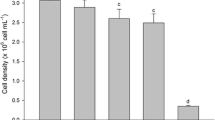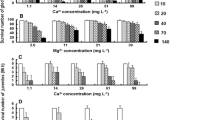Abstract
Anemonia viridis (Forskäl) were collected from south-west Scotland and south-west England in October 1988. When exposed to 0.05 and 0.2mg 1−1 copper in sea water, anemones did not take up the metal in proportion to external concentrations. Results suggested thatA. viridis regulated copper by expelling symbiotic algae (or zooxanthellae) which were shown to accumulate copper. The use of aposymbiotic (non-zooxanthellate) anemones in similar metal-uptake experiments indicated that other mechanisms may also be involved in metal regulation. Mucus was produced byA. viridis when the anemone was exposed to copper, and it is proposed that mucus may be involved in the regulation process. The implication of this work on the use of coelenterates as biological indicators of environmental metal levels is discussed.
Similar content being viewed by others
Literature cited
Benson, A. A., Summons, R. E: (1981). Arsenic accumulation in Great Barrier Reef invertebrates. Science, N.Y. 211: 482–483
Brown, B. E. (1977). Uptake of copper and lead by a metal tolerant isopodAsellus meridianus Rac. Freshwat. Biol. 7: 235–244
Brown, B. E. (1982). The form and function of metal containing ‘granules’ in invertebrate tissues. Biol. Rev. 57: 621–627
Brown, B. E., Holley, M. C. (1982). Metal levels associated with tin dredging and smelting and their effect upon intertidal reef flats at Ko Phuket, Thailand. Coral Reefs 1: 131–137
Brown, B. E., Howard, S. (1985). Responses of coelenterates to trace metals: a field and laboratory evaluation. Proc. 5th int. coral Reef Congr. 6: 465–470 [Gabrié, C. et al. (eds.) Antenne Museum-EPHE, Moorea, French Polynesia]
Bryan, G. W. (1971). The effect of heavy metals (other than mercury) on marine and estuarine organisms. Proc. R. Soc. (Ser. B) 177: 389–410
Bryan, G. W. (1974). Some aspects of heavy metal tolerance in aquatic organisms. In: Lockwood, A. P. M. (ed.) Effects of pollutants on aquatic organisms. Cambridge, England, University Press, p. 7–34
Bryan, G. W., Gibbs, P. E. (1983). Heavy metals in the Fal estuary, Cornwall: a study of long term contamination by mining waste and its effects on estuarine organisms. Occ. Publs mar. biol. Ass. U.K. 2: 1–112
Buddemeier, R. W., Schneider, R. C., Smith, S. V. (1981). The alkaline earth chemistry of corals. Proc. 4th int. Symp. coral Reefs 2: 81–85. [Gomez, E. D. et al. (eds.) Marine Sciences Center, University of the Philippines, Quezon City]
Coughtrey, P. J., Martin, M. H. (1976). The distribution of Pb, Zn, Cd and Cu within the pulmonate molluscHelix aspersa Müller. Oecologia (Berl.) 23: 323–334
Davies, M. (1988). Nitrogen flux in the symbiotic sea anemoneAnemonia viridis (Forskäl). Ph. D. thesis. University of Glasgow
Dykens, J. A. (1984). Enzymatic defenses against oxygen toxicity in marine cnidarians containing endosymbiotic algae. Mar. Biol. Lett. 5: 291–301
Esquivel, I. (1986). Short term copper bioassay on the planula of the reef coralPocillopora damicornis. Tech. Rep. Hawaii Inst. mar. Biol., Univ. Hawaii, Honolulu 37: 465–472
Evans III, E. C. (1977). Microcosm responses to environmental perturbants. An extension of baseline field survey. Helgoländer wiss. Meersunters. 30: 178–191
Glynn, P. W. (1984). Widespread coral mortality and the 1982–1983 El Niño warming event. Envir. Conserv. 10: 149–154
Goreau, T. F. (1964). Mass expulsion of zooxanthellae from Jamaican reef communities after Hurricane Flora. Science, N.Y. 145: 383–386
Gupta, B. L., Hall, T. A. (1984). Role of high concentrations of Ca, Cu and Zn in the maturation and discharge in situ of sea anemone nematocysts as shown by X-ray microanalysis of cryosections. In: Bolis, L. et al. (eds.) Toxins, drugs and pollutants in marine animals. Springer-Verlag, Berlin, Heidelberg, p. 77–95
Harland, A. D., Brown, B. E. (1989). Metal tolerance in the scleractinian coralPorites lutea. Mar. Pollut. Bull. 20: 353–357
Harriott, V. J. (1985). Mortality rates of sleractinian corals before and during a mass bleaching event. Mar. Ecol. Prog. Ser. 21: 81–88
Howard, L. S., Crosby, D. G., Alino, P. (1986). Evaluation of some of the methods for quantitatively assessing the toxicity of heavy metals to corals. Tech. Rep. Hawaii Inst. mar. Biol., Univ. Hawaii, Honolulu 37: 452–464
Howell, R. (1982). The secretion of mucus by marine nematodes (Enoplus spp.). A possible mechanism influencing the uptake and loss of heavy metal pollutants. Nematologica 28: 110–114
McAuley, P. J. (1986). Isolation of viable uncontaminatedChlorella from green hydra. Limnol. Oceanogr. 31: 222–224
Meikle, P., Richards, G. N., Yellowlees, D. (1988). Structural investigations on the mucus from six species of coral. Mar. Biol. 99: 187–193
Moore, M. N. (1985). Cellular responses to pollutants. Mar. Pollut. Bull. 16: 134–139
Schoenberg, D. A., Trench, R. K. (1980). Genetic variation inSymbiodinium (=Gymnodinium)microadriaticum Freudenthal, and specificity in its symbiosis with marine invertebrates. III. Specificity and infectivity ofSymbiodinium microadriaticum. Proc. R. Soc. (Ser. B) 207: 445–460
Sokal, R. R., Rohlf, F. J. (1981). Biometry. The principles and practice of statistics in biological research. 2nd ed. W. H. Freeman & Co., San Francisco
Stebbing, A. R. D., Brown, B. E. (1984). Marine ecotoxicological tests with coelenterates. In: Persoone, G. et al. (eds.) Ecotoxicological testing for the environment. Vol. 1. State University Ghent and Institute of Marine Scientific Research, Bredene, Belgium, p. 307–339
St. John, B. E. (1972). Trace elements in corals of the Coral Sea: their relationship to oceanographic factors. In: Fraser, R. (ed.) Oceanography of the South Pacific. New Zealand Commission for UNESCO, Wellington, p. 149–158
Tytler, E. M., Spencer Davies, P. (1983). A method of isolating clean and viable zooxanthellae by density gradient centrifugation. Limnol. Oceanogr. 23: 1266–1268
Van-Praet, M. (1977). Les cellules a concretions d'Actinia equina L. C. r. hebd. Séanc. Acad. Sci., Paris 285: 175–179
Veeh, H. H., Turekian, K. K. (1968). Cobalt, silver and uranium concentrations of reef building corals in the Pacific Ocean. Limnol. Oceanogr. 13: 304–308
Zar, J. H. (1974). Biostatistical analysis. Prentice Hall, New Jersey
Author information
Authors and Affiliations
Additional information
Communicated by J. Mauchline, Oban
Rights and permissions
About this article
Cite this article
Harland, A.D., Nganro, N.R. Copper uptake by the sea anemoneAnemonia viridis and the role of zooxanthellae in metal regulation. Mar. Biol. 104, 297–301 (1990). https://doi.org/10.1007/BF01313271
Accepted:
Issue Date:
DOI: https://doi.org/10.1007/BF01313271




